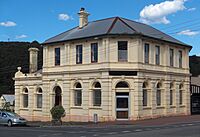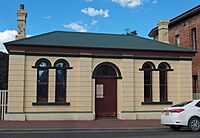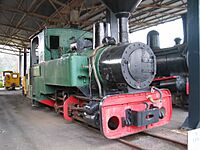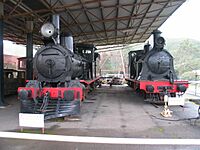Zeehan facts for kids
Quick facts for kids ZeehanTasmania |
|||||||||
|---|---|---|---|---|---|---|---|---|---|
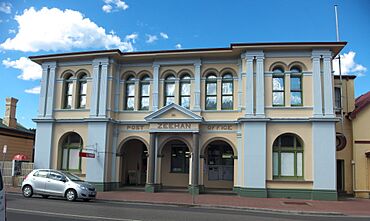
Zeehan Post Office, opened 1 August 1888
|
|||||||||
| • Density | 404.4/km2 (1,047/sq mi) | ||||||||
| Postcode(s) | 7469 | ||||||||
| Elevation | 172 m (564 ft) | ||||||||
| Area | 1.8 km2 (0.7 sq mi) | ||||||||
| Location |
|
||||||||
| LGA(s) | West Coast Council | ||||||||
| State electorate(s) | Braddon | ||||||||
| Federal Division(s) | Braddon | ||||||||
|
|||||||||
Zeehan is a town on the west coast of Tasmania, Australia. It is about 139 kilometers (86 miles) south-west of Burnie. Zeehan is part of the West Coast Council. This council also includes the port town of Strahan and nearby mining towns like Rosebery and Queenstown.
Contents
Discovering Zeehan's Past
The area around Zeehan was home to the North West group for over 10,000 years. These groups included the Peerapper and Tommeginne clans. They mostly lived near the coast. Their diet included birds, seals, and eggs. They built bark huts to protect themselves from strong winds and cold rain.
European Explorers Arrive
On November 24, 1642, a Dutch explorer named Abel Tasman was the first European to see the Heemskirk and West Coast Ranges. Tasman sailed his ships close to the coast. However, bad weather stopped him from sending a group ashore. He did not meet any local Aboriginal people.
Later, between 1798 and 1799, George Bass and Matthew Flinders sailed around Tasmania. They named Mount Heemskirk and Mount Zeehan after Tasman's ships. His warship was the Heemskerck and his cargo ship was the Zeehaen. The name "Zeehaen" means "Sea Rooster" in Old Dutch. These names are some of the oldest British place names in Tasmania.
The Mining Boom Era
In 1871, tin was found nearby at Mount Bischoff. More tin was found at Mount Heemskirk in 1879. Then, in 1882, Frank Long discovered silver and lead in the Zeehan area. The Mount Zeehan Post Office opened on August 1, 1888. The town was officially named Zeehan in 1890.
Zeehan grew very quickly because of the rich Zeehan mineral field. The busiest time for mining was before the First World War. At its peak, 159 mining companies operated in the town. The town's stock exchange had 60 members. Zeehan's main street was over 3.2 kilometers (2 miles) long. It had more than 20 hotels, a hospital, and two theaters. These were the Gaiety Theatre and the Theatre Royal.
Zeehan was known as the Silver City during the silver boom. It had a friendly competition with Queenstown. In the early 1900s, Zeehan was the third largest town in Tasmania. Only Hobart and Launceston were bigger. The nearby mining area of Dundas was also closely linked to Zeehan.
A port was set up at Trial Harbour for Zeehan. But strong winds made it a dangerous place for ships. After the Strahan–Zeehan Railway was built, Strahan became Zeehan's main port. The mines brought in a lot of money for about 20 years. Then, mining slowly declined until the 1960s, when the last mines closed.
Zeehan's Changing Times
The population of Zeehan and Dundas reached about 10,000 people around 1910. This is more than ten times the current population. In the 1970s, the town saw more activity because of the nearby Renison Bell tin mine. There was another boost in the 1990s.
Zeehan used to have its own town council. But in the early 1900s, it joined with other councils to form the Municipality of West Coast. In 2011, Zeehan had a population of 728 people.
During the COVID-19 pandemic, the West Coast Council sold some land parcels. Some were as cheap as $8000. This was done to attract new residents. People hope that tourism will help the local economy. A new takeaway shop has opened. A local newspaper, The Western Echo, has also started. A model railway and diorama display about West Coast history is now open. It is being built as a tourist attraction. The area has also become popular for mountain biking. New trails have been created around Zeehan, Trial Harbour, and Queenstown.
Environmental Concerns
In 2021, a study looked at pollution levels in lakes in northwest Tasmania. It found high levels of lead, copper, cadmium, and arsenic. These levels were similar to the most polluted lakes in the world. Owen Tarn and Basin Lake near Queenstown were the worst. Other lakes like Dove Lake were also affected.
These lakes are in the mountains up to 130 kilometers (80 miles) downwind from Zeehan and Queenstown. The pollution mainly came from open cut mining that was not controlled for a long time. This changed after the Environment Protection Act of 1973. Recent bushfires have also increased mercury levels in the air. This is because mercury stored in trees is released when they burn. Evidence shows that the area has had dangerous pollution levels for over a century.
Getting Around Zeehan
Zeehan is connected to other parts of Tasmania by roads.
- The Murchison Highway connects it to the north coast.
- The Zeehan-Strahan Road connects it to Strahan.
- The Zeehan Highway connects it to Queenstown.
Zeehan's Railway History
Zeehan was an important railway hub. It was the end point for the Emu Bay Railway. It was also the start of the government-owned Strahan-Zeehan Railway. This railway connected Zeehan to Strahan and Regatta Point. From Regatta Point, the Mount Lyell Railway went to Queenstown.
In the early days, many timber tram lines spread out from Zeehan. They went towards the Pieman River and other places. Some smaller railways east of Zeehan were very special. One even had the first Garratt locomotive ever designed and built for its use.
After the government railway between Zeehan and Strahan closed, the Mount Lyell Company used trucks. They trucked their copper ore to the Emu Bay Railway at Melba Flats. This spot is a few kilometers east of Zeehan.
Local News
The 'Western Echo' is the current newspaper for the west coast. It covers news from Zeehan, Queenstown, Strahan, Rosebery, Tullah, and Waratah. You can also learn about the historic Zeehan and Dundas Herald.
Zeehan's Economy
Several mines are important for Zeehan's economy. These include Dundas Mining's Avebury nickel mine and Bluestone Tin's Renison Bell tin mine. However, most of the town's income now comes from tourism.
In 2018, work began on the $280 million Granville Harbour Wind Farm. This is Tasmania's tallest wind farm. It is located 35 kilometers (22 miles) north-west of Zeehan. This wind farm helped Tasmania reach 100 percent renewable energy. In 2020, it was Australia's best performing wind farm. In 2022, the Avesbury mine reopened, bringing new jobs and chances for Zeehan and nearby areas.
Places to Visit
Zeehan's main street is a key feature of the town. It has many buildings from the boom-time era. These include the Gaiety Theatre and the Grand Hotel. The West Coast Heritage Centre is also a popular spot. It used to be called the West Coast Pioneers Museum. It is located in the old Zeehan School of Mines and Metallurgy building. The Heritage Centre displays crocoite, which is Tasmania's valuable mineral emblem. It also has other cool rocks and old mining tools.
Famous People from Zeehan
- The famous concert pianist Eileen Joyce was born in Zeehan. The Eileen Joyce Memorial Park in Zeehan is named after her.
- Reverend Dorothy McRae-McMahon, a human rights activist, was also born in Zeehan.
Notable Events
- Parts of a 1925 Australian silent film, Jewelled Nights, were filmed near Zeehan. This happened on Savage River, north of the town.
- Bushfires have been reported near Zeehan many times. Some notable years include 1896, 1908, 1977, 1980, and 2006. In November 2012, fires threatened the town from two directions.
- In 2019, bushfires again threatened Zeehan. The fire came within about 2 kilometers (1.2 miles) of the town. Residents had to leave and go to Queenstown and Strahan.
- In 2022, a crime drama TV series called Bay of Fires was filmed in Zeehan. It also used locations in Queenstown and Strahan.
Zeehan's Climate
Zeehan has a cool, wet oceanic climate. This means it has cool, damp summers. Winters are long, chilly, and rainy. Snow falls in Zeehan about 2.4 days each year.
| Climate data for Zeehan Post Office (1908–1968, rainfall 1890–1968); 172 m AMSL; 41.88° S, 145.33° E | |||||||||||||
|---|---|---|---|---|---|---|---|---|---|---|---|---|---|
| Month | Jan | Feb | Mar | Apr | May | Jun | Jul | Aug | Sep | Oct | Nov | Dec | Year |
| Mean daily maximum °C (°F) | 19.5 (67.1) |
20.2 (68.4) |
18.4 (65.1) |
15.4 (59.7) |
13.2 (55.8) |
11.2 (52.2) |
10.8 (51.4) |
11.5 (52.7) |
13.3 (55.9) |
14.9 (58.8) |
16.3 (61.3) |
18.2 (64.8) |
15.2 (59.4) |
| Mean daily minimum °C (°F) | 8.8 (47.8) |
9.5 (49.1) |
8.4 (47.1) |
6.9 (44.4) |
5.5 (41.9) |
3.8 (38.8) |
3.4 (38.1) |
3.8 (38.8) |
4.8 (40.6) |
5.7 (42.3) |
6.9 (44.4) |
8.2 (46.8) |
6.3 (43.3) |
| Average precipitation mm (inches) | 137.6 (5.42) |
113.8 (4.48) |
151.0 (5.94) |
215.7 (8.49) |
237.8 (9.36) |
252.2 (9.93) |
264.9 (10.43) |
262.5 (10.33) |
229.7 (9.04) |
221.2 (8.71) |
189.6 (7.46) |
165.3 (6.51) |
2,441.3 (96.1) |
Gallery






